CONTRA – NES VERSION
NINTENDO ENTERTAINMENT SYSTEM
•Release Information
•Overview
•Demos
•Stages
•Arsenal
•Opposition
•Cheats & Tips
•Full Plot
•Soundtrack
•Variants
•Regional Differences
•Developmental Material
•Technical Information
•Trivia
•Promotional Media
RELEASE INFORMATION
Title: Contra
Media/Formats: Cartridge
Developer: Konami
Publisher: NTSC-J: Konami
NTSC-U: Konami
PAL: Konami
Release: NTSC-J: February 9, 1988
NTSC-U: February 2, 1988
PAL: December 28, 1990
Top of page
OVERVIEW
Contra on the NES is the most famous version of the original game. It is also the most famous game in the entire Contra series. Gamers grew up with this home version and have fond memories of the action-packed, challenging experience.
It is unsurprising that the arcade original is not as notable and is overall considered inferior to this version. Contra on the NES features smoother and more responsive controls, more vibrant colors, a better-suited aspect ratio, better rendition of the music; a more memorable gaming experience overall.
This version generally retains the structure of Contra on the arcade. One of the major difference lies in this game’s length, as it is significantly greater than its arcade counterpart. The levels themselves are longer and restructured, but in addition, the last level is now split into 4 separate ones.
Another major difference can be seen in the display: Contra on the NES caters to the horizontal orientation of home displays, compared to the arcade original’s vertically stretched screen.
There are also notable boss battle changes. In the arcade version, the waterfall’s boss battle (the entrance to the second base) involves destroying a building whose upper portion resembles 2 alien heads. In the NES conversion, the player fights an actual alien, single-headed and with flailing arms, overlooking the base’s entrance.
The sequence of boss battles in the latter half of the game is also rearranged (in particular, during the Snowfield and Energy Zone stages). The base stages are entirely linear (and don’t display a map) and are not time-based. The player characters are now blue and brown sprite palette swaps, as opposed to 2 distinct characters.
As mentioned before, the structure generally resembles the arcade original. There are, of course, deviations in the gameplay and graphics. For instance, all powerups are represented by falcons and always appear in their preset locations, regardless of the player’s circumstances. The barrier is more frequently available. A new powerup, a flashing falcon that clears all enemies on-screen, appears in the Snowfield stage.
Choosing to continue after getting a game over starts the player at the beginning of their current stage, as opposed to the spot where they lost their last life like in the arcade original.
Contra on the NES is considered the superior version and among the best titles in the series. The controls are highly responsive; a standard screen ratio also improves the experience, as many dislike the vertically stretched screen of the arcade original, feeling that it is visually uncomfortable for a predominantly horizontally scrolling shooter.
It also features sound effects that feel more powerful and renditions of the soundtrack that are much more memorable. The 2-player mode that it retains amplifies how much of a fun experience that NES Contra has to offer. It also highlights the detrimental downside that a lack of communication between players can be to succeeding in the game, an element that is prominently carried on throughout the series.
In later years, Contra became well known for its Japanese regional release, on the Famicom. It is characterized by several enhancements to the presentation: graphical upgrades, as well as the addition of cinematic sequences (see below).
The NES version of Contra is featured in the following compilations:
•Konami Collector’s Series: Castlevania & Contra – Windows (additionally, see here)
•Contra 4 – Nintendo DS, as a bonus game
•Contra Anniversary Collection – Multi-platform (additionally, see here)
Covers:
NTSC-J
NTSC-U
Revision A:
Revision B:
PAL
PAL A:
PAL A (Australia):
PAL B:
PAL B (bilingual):
DEMOS
Store Demo:
Sample version of the Japanese release, restricted to the first 2 levels, demonstrated in shops in Japan. Click here for more information.
Top of page
STAGES
Stage 1: Jungle
Stage 2: Base 1
Stage 3: Waterfall
Stage 4: Base 2
Stage 5: Snow Field
Stage 6: Energy Zone
Stage 7: Hangar
Stage 8: Alien’s Lair
Top of page
ARSENAL
Powerups are acquired through various objects and certain enemies scattered throughout the game.
-Ground canisters:
-Blimps:
-Specific enemies in the Base stages:
(NTSC-J/NTSC-U):
(PAL):
Normal Gun:
The player starts with this gun and, assuming they have a gun powerup, will revert to it when respawning after death. It can be fired at a fast rate by rapidly pressing the fire button.
Machine Gun (M):
Shoots a rapid stream of bullets, fired automatically.
Fireball Gun (F):
Shoots small fireballs in a corkscrew trajectory. Can be difficult to use as a result of this, as well as its slow rate of fire. inflicts slightly more damage than the regular bullets.
Laser Gun (L):
Shoots a long laser beam that causes massive amounts of damage. Although it is the strongest gun, it is quirky to use. If the player fires while any part of the beam is already on screen, that beam disappears and a new one fires from the gun.
Spread Gun (S):
Shoots 5 large bullets that fan out, with a high rate of fire. Useful for multiple targets and large groups of enemies at far range and inflicts heavy damage at close range. Due to the game’s handling of player bullets on-screen, excessive firing will cause the bullets to gradually lose their formation, spreading less and less. It is considered the game breaker of Contra. The Spread Gun is the iconic weapon of the Contra series.
Special:
A glowing falcon powerup that clears all enemies on-screen. It is found once in the entire game, in the fifth stage.
Rapid Fire (R):
Increases the speed of all of the guns’ bullets/shots, except for the Laser Gun.
Barrier (B):
The player rapidly blinks red, during which they are protected from enemies and attacks. The effect lasts for approximately 30 seconds.
Credit to Game Kommander for the images presented.
Top of page
OPPOSITION
Most, if not all of the names provided here are unofficial. Due to the ambiguity of enemy names between regions, the lack of names for several of them and the absence of various documents, it is impractical to list the correct designations. Help is strongly encouraged and always appreciated to fill in these blanks. The Opposition section serves primarily to describe and depict the enemies for bookkeeping; thus, the content presented below hopefully satisfies this criterion.
Note: Enemies and objects that take multiple hits to defeat have increased strength with increasing difficulty.
Fodder Enemies, Objects
The weakest and most basic enemy of Contra. They predominantly run along sections of numerous stages. Occasionally, they jump off the edge of grounds in an attempt to chase the player, though this sometimes results in them falling to their death. In later stages, they will stop running to fire while either standing (2 rounds) or ducking (1 round).
Their tendencies to fire (both methods) and jump from edges vary with certain factors: stage, difficulty (loop number), player actions and player’s current gun. Their spawning number increases with increasing difficulty.
Probotector designation: Bipedal Buggy
Found in stages: 1,3,5-7
Standing Sniper:
This soldier stands in place, actively changing aim to follow the player and firing in a constant pattern.
Probotector designation: Standing Sniper Bot
Found in stages: 1,3,5-7
Guerrilla Sniper:
Hidden in the background bushes, these enemies periodically spring out and shoot horizontally towards the player’s side. They are vulnerable only when they stand up to fire.
Probotector designation: Guerrilla Bot
Found in stages: 1
Smart Turret:
Embedded in the ground, these turrets are able to fire in 16 directions. They actively seek out the player’s position.
Found in stages: 1,3
Ground Arc Turret:
Hidden in the ground, they rise up and out when the player reaches close proximity. Always facing to the left, they are able to fire in 3 directions, including horizontally, that form a partial arc range.
Found in stages: 1,3
Stationed at the roof of the Wall. This soldier is hidden most of the time, but occasionally stands at the roof’s edge to actively aim and fire 3 shots at the player. He is vulnerable only when revealed.
Probotector designation: Sharpshooter Bot
Found in stages: 1
Hopping Troop:
Hops across the far end wall in various corridors, firing a bullet each time he lands. After a while, they stop spawning.
Probotector designation: Hopping Buggy
Found in stages: 2,4
Base Rifle Foot Soldier:
Runs across some corridor walls, occasionally firing a few bullets. After a while, they stop spawning.
Probotector designation: Base Rifle Bipedal Buggy
Found in stages: 2,4
Rifle Clique Soldier:
Appears in groups of 5; they run to the center of the corridor, then spread out, stopping every few steps to fire. After a while, they stop spawning.
Probotector designation: Rifle Clique Bipedal Buggy
Found in stages: 2,4
Running Grenadier:
Runs across some corridor walls, throwing a grenade every few steps. After a while, they stop fspawning.
Probotector designation: Bipedal Buggy Grenadier
Found in stages: 2,4
Strategic Grenadier:
Strafes step-by-step with pauses, aligning with the player. Once he does, he throws a grenade towards the player’s position. After a while, they stop spawning.
Probotector designation: Strategic Bipedal Buggy Grenadier
Found in stages: 2,4
Powerup Hopper:
Harmlessly hop across the far end wall in various corridors. Upon defeat, they yield a gun powerup for the player. Distinguished from the rest of the enemies by their red attire (all other soldiers sport green uniforms).
Probotector designation: Powerup Bipedal Buggy Hopper
Found in stages: 2,4
Base Turret:
Disarmed and placed in various positions on various corridor walls until reached by the player. These turrets fire a bullet less than once per second. They actively aim at the player’s position.
Found in stages: 2,4
Disarmed and placed in various positions on corridor walls, these small cores are exposed when reached by the player. The Base Sub-Cores (and Base Cores) are the goal of the corridors. These ones are found on all corridor walls that precede the one with the Base Core. All other opposition are optional; destroying these will clear the enemies present, destroy the far wall and disarm the Electrical Barrier to allow the player to proceed.
If these cores aren’t destroyed within a certain amount of time, they will begin firing bullets at the player, at a much higher rate than the Base Turrets.
Found in stages: 2,4
Sub-Core Shield:
These can be found placed in front of the Base Sub-Cores in some corridors of Base 2. They are shiny, steel, protective boxes that serve as a temporary barrier to the Base Sub-Cores. They appear cracked and damaged the more they are shot.
Found in stages: 4
Primary goal of the Base stages, they are found on the center of the corridor wall immediately before a boss battle. Initially disarmed, these large cores are exposed when reached by the player. They take more damage than Base Sub-Cores. All other opposition are optional; destroying these will clear the enemies present, destroy the far wall and disarm the Electrical Barrier to allow the player to proceed to the boss battle that follows.
If these cores aren’t destroyed within a certain amount of time, they will begin firing bullets at the player, at a much higher rate than the Base Turrets.
Found in stages: 2,4
Bowling Pin Mine:
Rolls along some corridor floors towards the player. They’re launched in a line of 5 from holes at the ground level of certain walls; this is how to predict which corridors will use this attack. They can be destroyed.
Found in stages: 2,4
Shot by Lone Inflammatory Eye Garumakiruma. Their large size makes them easy to hit, but also difficult to dodge.
Probotector designation: Red Fire Ring
Found in stages: 2
Hidden in the water, they are inactive until the player climbs past them. These soldiers periodically emerge to fire a shell upwards. The shell splits into 3 smaller ones that drop back down and explode upon impact. These enemies are vulnerable only when they emerge.
Probotector designation: Scuba Bot
Found in stages: 3,5
Falling Boulder:
Out of holes in mountain rock, these destructible boulders occasionally drop out and bounce down the platforms.
Found in stages: 3
Runs near the computer mid-line and jumps down to the player, wings open.
Probotector designation: Winged Bot
Found in stages: 4
Stops at various positions along the 2 computer platforms and actively shoots at the player’s position for a few seconds before running off-screen.
Probotector designation: Defense Bot
Found in stages: 4
Shot by Splitting Illusionary Ogre Godomuga. They follow a variety of eccentric patterns, usually rapidly homing in on the player.
Found in stages: 4
Manned Turret:
Consists of a soldier who is protected by, and shoots through, a gun turret. He fires a bullet approximately once every 1.5 seconds.
Probotector designation: Bipedal Turret
Found in stages: 5-7
They fly a short distance in the air before lowering to the ground and approaching the player. If dodged, these machines simply slide on the ground off-screen.
Probotector designation: Pocket Sentry UFO
Found in stages: 5
Thick projectile that the High Speed Anti-Gravity Hovercraft fires straight down from its center.
Found in stages: 5
Impale Board:
Spring up out of the ground when the player approaches them, serving as a speed trap. They are found in a variety of heights, with the higher ones taking more damage.
Found in stages: 7
Carrier Cart:
Simply rolls across the screen, although some are found stationary. Running into either of its sides will kill the player. In this conversion of Contra, these carts play a bigger role in the stage with the platforming segments (reaching higher grounds). Players can induce a stationary cart to move in the direction they’re facing by landing on it; they can also change the direction of a moving one in the same way.
Probotector designation: Buggy Carrier Cart
Found in stages: 7
Spat from the mouth of Emperor-Demon Dragon God Java and also appear shortly prior. These alien creatures fly across the screen. Some of them home in on the player, while others move in various patterns.
Found in stages: 8
Alien mouths embedded in the walls. They spit out Cotton Balls; the spitting rate increases with increasing difficulty.
Found in stages: 8
Spat out from Wall Mouths. They fly slowly before rapidly homing in on the player.
Found in stages: 8
These alien eggs surround and protect Emperor-Demon Evil Heart Gomera Mosking. They hatch an unlimited number of Face Huggers.
Found in stages: 8
Spawned from Face Hugger Eggs, these alien arachnids also appear shortly prior to the confrontation with Emperor-Demon Evil Heart Gomera Mosking. They rapidly crawl along the ceiling or ground and often swap surfaces through the air, making them difficult to dodge.
Found in stages: 8
Mini-Bosses
Heavy Armored Vehicle Sweeping Dogura:
The player must battle 2 of these armored trucks, one shortly after the other. When first confronted, the trucks slow down to a stop. Their prominence is the large amount of shots required to destroy them. In contrast, their only attack is firing a continuous stream of bullets with their gun that tracks the player’s position. These bullets are dodged by standing either really close to the truck or at the far left of the screen. As they sustain more damage, their colors change.
If the trucks are not destroyed in a certain amount of time, they will stop firing, resume driving and (if not destroyed in time) kill the player as they leave the screen. In this sense, these armored trucks are optional mini-bosses. In the Japanese version of the game, the trucks also resume driving after receiving enough damage to change color the first time.
Found in stages: 5
Emperor-Demon Dragon God Java:
Fought at the start of Stage 8. Large xenomorph head that spits out Alien Fetuses. The rate of fetuses spat out increases with increasing difficulty.
Found in stages: 8
Bosses
Building entrance to the first Base stage. A siren sounds off when approached. This defense bunker consists of a Sharpshooter on the roof, dual Mortar Cannons at mid-level and the Wall Core at ground level. The Mortar Cannons frequently fire bombs, at various distances (randomly). As the cannons and rooftop snipers are optional, simply destroying the Wall Core will defeat the boss and complete the stage.
Found in stages: 1
The boss battle that follows Base 1. When first reached, the player is confronted by the first phase, consisting of Shell Turrets (ST) and Defense Cores (DC) in the following arrangement:
ST DC ST
DC DC DC
The Shell Turret cycles between opening up to fire 3 shells in a spread formation and closing for a few seconds. It’s vulnerable only in the latter phase. The Defense Cores, which are harmless, are the goal of the first phase. Although destroying the Defense Cores activates the second phase, it is recommended to destroy the Shell Turrets beforehand in order to make the second phase easier.
The ultimate goal of this boss battle is destroying Lone Inflammatory Eye Garumakiruma, the second phase. This eye-shaped robot slides back and forth within the security screen, actively aiming and shooting large destructible Blue Fire Rings (Probotector designation: Red Fire Rings) at the player. The firing frequency increases with increasing difficulty and also as it is sustains more damage. The robot pulses red when taking damage.
Found in stages: 2
Shadow Beast Entrance:
Resting atop the waterfall, this towering alien is the entrance to the second Base stage. Its attacks consist of small fire rings thrown from its Mouth and its Flailing Arms, and the Flailing Arms themselves. Each Flailing Arm rotates, alternating between clockwise and counter-clockwise, occasionally throwing a small fire ring at the player’s position.
Its Mouth spits 3 small fire rings in a spread formation; this component is the goal of this boss battle, while the arms are optional. The Mouth is vulnerable only when it opens to spit fire rings. It is recommended to destroy the arms to make the battle easier.
Probotector designation: Shadow Demon Entrance
Found in stages: 3
The boss battle that follows the second Base stage. When first reached, the player is confronted by the first phase, consisting of a Shell Turret (ST) and Defense Cores (DC) in the following arrangement:
ST
DC DC DC
The Shell Turret cycles between opening up to fire 3 shells in a spread formation and closing for a few seconds. It’s vulnerable only in the latter phase. The Defense Cores, which are harmless, are the goal of the first phase. Although destroying the Defense Cores activates the second phase, it is recommended to destroy the lone Shell Turret beforehand in order to make the battle easier.
In addition to the aforementioned defense components, 2 enemy types run across 2 height levels on the computer wall and attack the player: Winged Soldier (Probotector designation: Winged Bot) and Defense Gunner (Probotector designation: Defense Bot). When phase 2 begins, they stop spawning.
The ultimate goal of this boss battle is destroying Splitting Illusionary Ogre Godomuga, the second phase. It consists of a pair of head-shaped robots that, on a periodic and temporary basis, simultaneously split into 2 virtual blinking images that separate a short distance before retracting and merging. Each head is vulnerable only when merged. Both the merged form and each virtual image fire destructible Bubble Dimers. The firing frequency increases with increasing difficulty and also as the head sustains more damage. The heads pulse red when taking damage and later permanently pulse red when almost destroyed.
Found in stages: 4
High Speed Anti-Gravity Hovercraft:
A small ship that floats in the air above the player. Its left and right side doors open and unload an infinite number of Pocket UFOs (Probotector designation: Pocket Sentry UFO). Additionally, the ship constantly drops Craft Bullets from a ventral hatch. As an interval, the ship periodically disappears and re-appears in a new position; it then resumes its attacks.
Found in stages: 5
Helmet Demonic Titan Soldier Gorudea:
A large, armored super-soldier. This boss tosses disc mines that slide along the ground towards the player. He throws either 1, 2 or 3 mines at a time, with varying time intervals between each (randomly). Occasionally, he jumps in place in an attempt to dodge the player’s bullets. He also walks across the battle area to the other side of the screen, at which point the player must jump over him. When damaged more and more, changes colors from blue to purple and then to red.
Probotector designation: Helmet Robotic Titan Soldier Gorudea
Found in stages: 6
Entrance Security System:
The final line of defense before the Alien’s Lair. This security system consists of a Security Lock above the entrance, a pair of Triple Mortar Turrets and Foot Soldiers.
Each Triple Mortar Turret is built into the ground, a few feet in front of the entrance. It launches a mortar shell very high into the air; the shell, like that of the Scuba Soldier, then splits into 3 smaller ones that drop back down. The turret periodically alternates between an open state (vulnerable), to attack, and a closed state (protected).
Occasionally, Foot Soldiers spawn in groups from the right (when the entrance door opens) and left sides of the screen. Once the Triple Mortar Turrets are destroyed, they stop spawning.
The main goal of this battle is the cross-shaped Security Lock above the entrance door; all other components are optional.
Found in stages: 7
Emperor-Demon Evil Heart Gomera Mosking:
Final boss of the game, an alien heart. The heart itself does not attack the player. The challenge comes from its defenses: several Face Hugger Eggs (that spawn Face Huggers surround it and some Wall Mouths can be present (if not destroyed prior to confronting the boss). All defenses are optional, but destroying at least some of them will make the battle easier. As the heart receives more damage, it beats faster.
Found in stages: 8
Other Dangers
Death Pit:
As the name implies, falling into these kills the player. Some are deep pits that make for a very high fall and a usually unknown or inescapable landing area. Others contain a deadly surface or a pool of dangerous substances.
Found in stages: 1,3,5-8
Though these don’t cost a life, they temporarily stun the player if the player attempts to run forward, rendering them vulnerable to other enemy attacks.
Found in stages: 2,4
Bridge Blaze Wall:
2 blaze walls move back and forth along the length of the Waterfall stage’s bridge.
Found in stages: 3
Thrown Grenade:
Grenades are thrown from the stage background, likely from a hidden enemy. They follow a narrow parabolic arc and are thrown in a preset pattern.
Probotector designation: Thrown Shell
Found in stages: 5
Exposed Flame Pipe:
These pipes periodically burst out a large beam of flames. They’re the prominence of the Energy Zone.
Found in stages: 6
Claw Compactor:
Compactors with claws at their base instead of the usual smasher set-up. They employ various impaling patterns with different triggers, requiring different evasive strategies.
Found in stages: 7
Credit to Game Kommander for most of the images presented.
Top of page
CHEATS & TIPS
Cheats
30 Lives: When the title screen scrolls left, or after the opening tune begins, press UP, UP, DOWN, DOWN, LEFT, RIGHT, LEFT, RIGHT, B, A, START.
30 lives will be provided in 1 Player mode. For 30 lives in 2 Player mode, use the same code above, but press SELECT before START. 30 lives are provided at the start of the game, as well as when continuing after a Game Over. This is the Konami Code.
Level Select Menu: NOTE: This code only works on the Famicom (Japanese) version of Contra.
After the title screen tune beings, hold UP+LEFT+A and press START and then immediately also hold SELECT.
Sound Test Menu: NOTE: This code only works on the Famicom (Japanese) version of Contra.
After the title screen tune begins, hold A+B and press START.
Glitches
Shoot While Ducking: In the base stages, while ducking (hold DOWN), hold UP on the second player’s controller. Although the player appears to remain prone, his bullets originate from the standing position.
Jump Higher: Note that this glitch is only beneficial in the Waterfall stage, as it is a vertically scrolling stage where the goal/destination requires climbing upwards. By moving left/right before the player reaches the peak of their jump, simultaneously while the screen is scrolling upwards, the maximum jump height can fluctuate in either direction.
The specifics are very complex. One of the game’s memory addresses must be at particular values; the address’ value is determined by the player’s jump trajectories and the player’s position in the level during the jump. When the address holds any of these values, the player will have a higher maximum jump height.
Using this glitch, it is possible to reach certain platforms that are too high to reach by jumping regularly. The precision required is very high such that exact timing is required. As a result, it is extremely difficult and thus, impractical to perform, except for tool-assisted speed runs.
Break Stage 4 Boss: If either of the heads are hit the immediate instant before they split into images, they will enter state of permanent vulnerability. As a result, they can be damaged constantly, even while split. As this trick requires the timing to be correct down to the single frame, it is next to impossible to perform.
Snowfield Bomb Glitch: Shortly after the R powerup appears near the start of the stage, there is a high platform where grenades are thrown at 2 adjacent spots. By satisfying certain memory address requirements (similar to the Waterfall jumping glitch above) to jump higher, and optionally varying the grenades’ spawning times, it is possible to dodge both grenades together in the jump and evade death, when timed right. If the player is off by even a single frame in timing, they will be killed by the grenades or their explosions. As with the Waterfall jumping glitch, this trick is suited for speed runs.
Flame Jump: In the Energy Zone stage, there is a segment where 2 flame beams, one horizontal and one vertical, cover a drop that must be crossed; a B powerup is located at the base of the drop. By jumping at a very specific moment, it is possible to jump over the vertical flame beam and skip the sequence of climbing out of the drop. The required precision for this trick makes it better suited for speed runs.
Hidden Elements
Secret Ending Message: NOTE: This secret can only be seen on the Famicom (Japanese) version of Contra.
Hold START+SELECT, starting from just before the end credits sequence begins until the end of it. A message will be displayed from Red Falcon, vowing his revenge.
Top of page
FULL PLOT
NTSC-J:
In the year 2633, a meteor crash-lands in the Galuga Archipelago. Subsequently, the area is seized by a terrorist organization named Red Falcon that seeks world domination. 2 soldiers, Bill Rizer and Lance Bean, are deployed to neutralize the terrorist threat. During the mission, it is revealed that the enemy is harboring alien entities, likely originating from the meteor. The soldiers eventually stop the terrorists and eliminate the aliens.
Characters
Bill Rizer – protagonist; playable
Lance Bean – protagonist; playable
Red Falcon – antagonist organization
NTSC-U:
Rather than in the future, the game takes place in then-present-day 1987, where an alien race, led by an entity termed Red Falcon, has infested a Mayan village and is planning universal domination. These aliens likely originated from what was presumed to be regular space debris that crashed near the region 30 years prior. 2 soldiers, Bill “Mad Dog” and Lance “Scorpion” are sent to destroy the alien threat. Eventually, the aliens are destroyed, resulting in the entire universe being saved.
Characters
Bill “Mad Dog” – protagonist; playable
Lance “Scorpion” – protagonist; playable
Red Falcon – antagonist; lead alien entity
PAL:
Also set in 2633, the plot of Probotector sees a future where science thrives. Top secret scientists discover that a malicious alien entity, Red Falcon, has set up a fortress in the fictional Galga Islands and intends to extinguish the human race. Sent to eliminate the aliens are 2 specialized robots, RD008 and RC011 (replacing Bill and Lance, respectively). The robots ultimately stop the alien threat, saving the entire universe (same as the North American release).
Characters
RD008 – protagonist; playable
RC011 – protagonist; playable
Red Falcon – antagonist; lead alien entity
Top of page
SOUNDTRACK
•Contra
•Intro (Japanese version only)
•Battle In The Dense Jungle
•Fortress Maze 1
•Fortress Maze 2
•Bloody Sault
•Fortress In The Ice
•Fortress In The Fire
•Pulse Of The Shudder
•Triumphal Return 1
•Triumphal Return 2 (Japanese version only)
•Sandinista
•Game Over
Top of page
VARIANTS
Black Nintendo Seal Variant:
White Nintendo Seal Variant:
Both versions are otherwise completely identical.
5-Screw Variant:
An extremely rare sub-variant of the North American release, with the white Nintendo Seal Of Approval, whose cartridge shell contains 5 screws (as opposed to 3, in regular cartridge shells).
PAL A Variants:
The A and B PAL variants differ only in their cartridges’ regional lockout chip, corresponding to their regions of release in Europe/Australia.
PAL B Variant:
The A and B PAL variants differ only in their cartridges’ regional lockout chip, corresponding to their regions of release in Europe/Australia.
Top of page
REGIONAL DIFFERENCES
NTSC-J: 魂斗羅 (Contra)
The Japanese version, for the Famicom, is the most functionally distinct version of the 3 regional releases. Because Konami handled the manufacturing of their own games in Japan, they were able to take advantage of the technology of their VRC2 chip for the game’s development. This allowed for several enhancements to the game, most notably with the additional cut scenes and graphics.
-Many level elements are (more) animated:
trees sway in the jungle stage;
the flashing light tiles at the very top of the stage 2 boss animate more elaborately;
the water is slightly different and animates more realistically in the waterfall stage; the rock formations are also slightly different;
the snowfield stage features flashing stars and actual snowfall in the foreground; the trees also sway;
the entire alien lair level pulses like it is alive and pulses faster as more of the level is complete, including damaging the boss; the level backgrounds before and around the boss are different from the overseas counterparts, as well as the lower 2 Face Hugger Eggs;
-All of the animating stage and boss elements continue to animate while the game is paused.
-The rock formation patterns in the Jungle and Waterfall stages are different.
-There is an intro sequence that explains the meaning behind Contra and provides the game’s back story.
-In the place of the intermission stats/score screens of the overseas counterparts are more elaborate cutscene sequences. The player character(s) communicate their status, often using a radio, followed by an animated map display that highlights the player’s progress and displays their stats/score. Levels are referred to as Areas, instead of Stages. The cutscene and map display intermissions can be skipped entirely, taking the player to the next level quicker than in the overseas counterparts.
-The game starts off at a higher difficulty than its overseas counterparts. In this version, the starting loop’s difficulty is the same as the second loop’s difficulty from the North American and PAL versions.
-2 player mode features some differences from 1 player mode. In the Jungle stage, the red sniper prior to the first Spread Gun powerup is in a slightly different position. In the Snowfield stage, the grenades thrown from the background are also at slightly different positions.
-On the Snowfield stage, the tank mini-bosses rush the player the first time they change color, as opposed to the overseas counterparts, where they rush the player after a fixed amount of time.
-In addition to the 30 lives cheat, there are cheat codes for level select and sound test. These latter 2 are dummied out in the overseas versions.
-The music played after beating the final boss is the one played after doing the same in the arcade original; the overseas releases lack this tune and simply play the regular victory tune.
-The screen transition effect after defeating the final boss is a fade-out effect; in the overseas counterparts, it is a more elaborate “blinds” effect.
-The ending sequence is extended and there is a hidden message at the end of the credits (see below).
-The ending does not present a congratulatory message before the credits roll. The credits are also formatted differently from the overseas counterparts. The Konami logo at the end of the credits sequence is replaced by text in the overseas counterparts. The Japanese version features a secret message after the credits, seen via a cheat code.
NTSC-U: Contra
-The title screen appears differently on start-up. In the Japanese version, everything fades into view and features an animated logo. In this version, the title screen scrolls into view from the right and the logos are static.
-The Waterfall stage boss’ arms are very slightly lower
PAL: Probotector
-This version uses the North American release as a base and replaces the player characters and many enemies with robots.
-Fodder enemy bullets are red, instead of white.
-The Stage 2 boss’ fire rings are red, instead of blue.
-The Waterfall boss’ arms feature different colors.
-The grenades thrown in the Snowfield background are gray, instead of blue.
-The carts in Hangar have black wheels, instead of blue.
-Strangely, the powerup blimps and icons in the last stage are a sharp pink in color.
-Apart from these visual changes during gameplay, the helicopter that escapes the destroyed island in the end cutscene is replaced by a fighter jet.
-The title screen appears instantly upon booting up the game.
Credit to TCRF for many of the differences listed above.
Top of page
DEVELOPMENTAL MATERIAL
-The designers of NES Contra’s box art seem to have taken some liberties with the screenshots on the backside.
Some colors are slightly different, certain elements are more detailed, the players’ rifles are larger and the sprites are also slightly different (ex: hairstyle). These shots are either mock-ups or had been taken from an early build of the game.
However, a brochure from Konami, advertising some of their NES games also includes this style of screenshot (see below).
Top of page
TECHNICAL INFORMATION
-The North American version of NES Contra does not feature a level select cheat, unlike the Japanese version. However, there is some code hidden in the game data for a level select option on the main menu. This code is activated in some bootleg versions of the game:
This hidden feature is strangely similar to the same feature seen in the Famicom (Japanese) version of Super Contra (see here).
-The Snowfield stage contains a satellite platform that the player(s) can hide out on. It is nothing more than a minor safe spot:
-As stated below, in the Trivia section, the game becomes more difficult on each consecutive run following completion. This gradual difficulty increase is intricately programmed. For example, upon reaching a specific high score, the player can gain only 1 extra life per run, and it is by defeating the last boss (heart). Additionally, enemies on stage 8 incrementally take more hits and in general, enemies attack more frequently and have an increase in projectile speed; as well, the number of enemies that spawn increases. It appears that this pattern is maintained until the 99th run, at which point the difficulty is at the maximum and simply repeats.
-Related to the previous information, the player’s score stops increasing once it reaches 6 553 500 points.
-Furthermore, certain aspects of the player’s status can affect the difficulty of enemies, such as the spawning rate of foot soldiers. For example, the rate increases based on the player’s gun in the following order: Normal, Fireball, Machine/Laser, Spread. Additionally, the rate is lower when the screen is scrolling (ie, when the player is progressing in the stage) than when it isn’t. The same applies to other enemy properties, such as the firing rate of foot soldiers and the 8-direction turrets.
-At each corridor (screen) of the base stages, the far end has a combination of wall turrets, wall targets and enemies that spawn from either side. If the player remains on the screen for a certain amount of time (by not destroying the wall targets), the wall targets will begin to actively fire bullets at the player’s location. Their rate of fire is higher than the wall turrets, making it much more difficult for the player to progress.
-The Famicom version features sequences that play before certain stages.
Before each of stages 2 to 6, the character is shown communicating via radio:
Before stages 7 and 8, the character is shown firing his gun:
Surprisingly, the game actually features sequences that are specific to the second player character:
If player 1 has the higher score and did not lose all of their lives when a stage is complete, the first set of cut scenes play. Otherwise, the second set of cut scenes play (Note: ee below for more about the cut scenes).
-The game contains unused code for a single mortar attack. The mortar is shot in a low, narrow arc.
TRIVIA
Konami, Not Contra:
The NES version marks the first game in the series to make use of the Konami Code, in addition to having cheats to begin with. Note, however, that the Konami Code originates from the NES version of Gradius, not Contra.
Not The First:
Konami Wai Wai World was released before Contra’s NES conversion. As such, the Alien Lair level BGM first appeared in a non-Contra game for home systems.
The Other Six Flags:
The Japanese version features an extended scene in the ending where the player(s) can be seen entering the helicopter. Interestingly, the number of flags on the side of the helicopter increases with each subsequent loop, for a maximum of 6.
Red Falcon Sort Of Made It Explicit:
The Famicom version of Contra includes a hidden message after the end credits. If the player holds start and select before the credits first appear, holding them down throughout the credits sequence, a message will appear from Red Falcon. In summary, Red Falcon promises retribution.
Harmless Borrowing:
There is no doubt that the penultimate boss, the alien head (Emperor Demon Dragon God Java), rips off the Xenomorph from the film Alien.
Similarly, the eggs surrounding the heart (Emperor-Demon Evil Heart Gomera Mosking) that constantly spawn alien arthropods are based on the Eggs from Aliens that spawn Face Huggers.
RobotsAliens In Disguise:
The fourth stage boss is likely inspired by the Transformers logo:
The Outstanding Exception
In 1993, game developer Sundog Systems released a version of Contra for the Tandy Color Computer 3, titled The Contras. Created and released without any confirmed license from Konami, it is an obscure, independently designed conversion and recreation of the NES game, with a fairly impressive degree of accuracy, playability and overall fidelity.
Due to the troubled development history, the quality is noticeably inconsistent throughout the game, especially the further the player progresses in the campaign.
The Contras features 3 stages from the NES version: Jungle, Energy Zone and Hangar; its 3 additional stages, unique to this game, are structural variants of the former 3. The visuals of NES Contra were implemented fairly well, albeit with lower detail. Simultaneous 2 player mode was also implemented.
Reflecting the rushed/unfinished nature, this game tends to crash on the occasion and features a lot of simplifications/omissions. For example, none of the gun powerups are functional except the Machine Gun, which however doesn’t feature auto-fire. Enemy behavior is also noticeably simplified.
The Contras is notable as an unlicensed title for being the earliest known of this kind, predating any other such known product. The primitive stage of the internet during this time meant that it likely had been one of the earliest in the context of fan games, as well. In contrast to the products of both aforementioned categories, the quality in design of this title far surpassed most, if not all of them.
For more information about The Contras, click here.
Contra: Uprising:
An arcade remake of NES Contra received a very limited release exclusively in China. Although released in 2011, development had been mostly finished in mid-2010; public testing was even conducted at a department store in Guangzhou (Canton), Guangdong, China, on August 12, 2010. Titled Contra: Evolution Revolution, this remake updates the graphics and incorporates many elements from Contra III, in addition to Contra: Hard Corps. The player can carry 2 guns, as well as smart bombs. There are 4 characters to choose from, 2 male and 2 female. To some extent, there are functional differences between the characters.
It appears that this remake was meant to capitalize on the upcoming Hard Corps: Uprising, as it shares similarities in the art style and character selection.
A mobile phone version was also released, heavily plugged by Konami of China. Although based on the aforementioned arcade remake, this conversion was released first, in 2010. There are a multitude of variations, all based on 3 main variants, as is the case with most mobile Contra games. The version depends on the handset’s capabilities. The mobile version is not well made, with unresponsive controls and abysmal collision detection. With the exception of multiplayer, it retains the essential aspects of its arcade counterpart.
Strangely enough, the mobile version was ported in Japan, through the Konami Net DX service. Notice the Japanese title screen below.
The mobile edition was used as a base for a heavily modified conversion, developed by Punchbox Studios, for Android and iOS devices in China. The primary changes are to the gameplay, adding new weapons, characters, as well as extensive level modifications and emphasis on pay-to-play gameplay. The visuals, while receiving updates, generally remain in the same style. The iOS re-release would temporarily be sold on the US App Store at the end of May, 2013 before being removed; it was given a definitive release the following month. For more information on this version, see here.
Polar Exceptions:
Contra on the NES and on the MSX2 can be considered the black sheep of the conversions. Whereas all other conversions follow the arcade original closely, these 2 versions deviate considerably from the original. The MSX2 version has several extra levels, while the NES version greatly changes the structure of the levels.
Not Gryzor:
A common misconception regarding the game’s title is that the Japanese original is called Gryzor. This misconception is still widespread today. Take 魂斗羅 (the Japanese title for most Contra games) and translate it; Gryzor is a word that will not be produced upon translation. The Japanese version of Contra is just called Contra.
Rambo VS Aliens:
The artwork for the Famicom version of Contra features Bill and Lance in poses based on Sylvester Stallone in Rambo: First Blood Part II.
The Biggest Misconception:
A severe misconception involves the North American artwork for the cartridge, manual and box of NES Contra. The second character (Lance) is mistakenly assumed to be based on Sylvester Stallone. In actuality, both characters on the cover are modeled after different poses of one Arnold Schwarzenegger in his film, Predator.
Additionally, that cover art did not begin with the NES game. It originated as the template Bob Wakelin created for the Gryzor conversions by Ocean:
This cover art would later be re-used on the back of MSX2 Contra’s cover.
Psycho Mantis Reversion:
In the NES version, player 1 can be controlled by a plugged-in second controller. This is the case for quite a span of NES titles. This feature can either be detrimental or advantageous. One example of the latter is in the base stages. While the character is ducking and firing via controller 1, pressing d-pad UP on controller 2 causes the bullets to shoot as if the character is standing.
Tandem Loop Motif:
The NES/Famicom version provides a genuine arcade feel with respect to the gameplay. Each time the player beats the game, after the credits, they are sent back to the first stage. However, the game gets incrementally more difficult on each following play. There will be a greater amount of enemies; they will move quicker, attack quicker and more often and many enemies increase in strength.
Regional Advantage:
The overall superior quality of the Famicom version is due to the fact that game companies can manufacture their games in-house in Japan. Thus, they were able to take advantage of technology like the VRC-2 chip’s enhancing properties for the game’s cartridge. This is what permits the numerous exclusive features.
Contra Force:
The word Contra in the title screen is reused in the title screen of Contra Force.
NES Contra:
Contra Force:
Konami Krazy Contra:
Konami Wai Wai World is a parody platforming video game released for the Famicom. Among the many Konami games it references is Contra. One of the stages is an alien/organic stage. It uses the music from Alien Lair; in fact, since this game was released before NES Contra, the Alien Lair BGM appeared in an NES game before NES Contra’s release.
Here’s a boss in the level, clearly based on the alien head (Emperor-Demon Dragon God Java):
Konami Wai Wai World was later converted to mobile phones, released in Japan through their Konami Net DX service.
Krazy Contra 2:
In the Famicom sequel, Wai Wai World 2: SOS!! Parsley Castle, there are even more parodies of Contra. One of your playable characters is Bill Rizer, who can use the default gun from NES Contra and Super C. In addition, one of the stages is a parody of Contra’s Jungle stage. It uses remixes of the Jungle and Alien Lair BGM’s, the latter for the boss fight.
Speaking of the boss fight, you fight a pink Xenomorph mounted on a hover device. It even uses a similar attack to that of Super Contra’s Xenomorph boss.
Aliens On Ice:
The NES version of Blades of Steel features intermission sequences during matches. Ads of other Konami games are shown on the jumbotron, including a playable mini-game of Gradius and the Contra logo:
This game was re-released for the Wii Virtual Console.
Pseudo-Foreshadowing:
The cutscenes in the Famicom version depict Bill Rizer with green combat pants and Lance Bean with purple combat pants.
Although these colors are incorrect with respect to their gameplay sprites, the characters would later sport attires with these colors in the arcade version of Super Contra
A Different Countdown:
Although the NES version’s base stages lack the timer of the arcade original, a measure is implemented to attempt to force the player to progress rather quickly, possibly as a substitute. If they do not destroy the wall targets quick enough, after a certain amount of time, the wall targets that are usually harmless will fire bullets at the player rather aggressively (see above).
Take Control, Literally:
On December 3, 2015, licensed pop culture collectibles giant NECA announced their production of Contra-themed action figures and pieces. Included in the set are 7″ tall figures of Bill and Lance, who are equipped with guns that represent the Machine Gun and Spread Gun through detachable bullet constructs (and whose outfits have been erroneously swapped); a powerup blimp on a float support stand; and a large box case with the North American NES version artwork.
These figures are slated for release in April, 2016.
Mad Dot And Spot:
3D Dot Game Heroes was developed by Silicon Studio for the PlayStation 3. Its gameplay is a throwback to numerous classic 8-bit games, including the early Final Fantasy titles. It also pays tribute and references a wide variety of other titles that span the 80’s and 90’s.
One example of references is the various images displayed on the loading screens. These images are dotted recreations of box art. One of the unlockable recreations is the NES Contra cover art:
PROMOTIONAL MEDIA
Posters And Ads
-Ads for the Famicom version:
-“Hot News” pamphlet included with the Famicom version:
Credit to user D.Lo of the Neogaf forums as the source for the third photo, from which this one is cropped.
-Poster of the North American version:
-Ad for the NES versions of Contra and Jackal (North America):
-Konami brochure Konami Introduces 10 Ways To Heat Up Your Nintendo Entertainment System (2 minor variants; KON-NES-US and KON-NES-US-1):
-Konami brochure There’s Only One Thing As Exciting As Our Ten Hit Video Games:
-Order card for Konami video game posters in North America, including Contra:
-Konami brochure There’s Only One Thing Exciting As Our 10 Hit Video Games:
-Sears catalog listing the North American version:
–Nintendo Catalogue 89/90, featuring the North American version:
–Les Nouveaux Défis 1988 catalog, listing Contra (North America):
–Nintendo Game Pak Catalog 1991, including Probotector:
–Nintendo Game Pak Catalog 1991/92, including Probotector:
–Des jeux passionants, featuring Probotector:
-Similar ad for Probotector in the catalog La passion des jeux:
–Nintendo Catalogue 90/91, featuring Probotector:
–Nintendo Catalogue 91/92, featuring Probotector:
–Total magazine, issue 6 includes a blurb for Probotector:
-German ad for the PAL release, Probotector (and Probotector II):
-Scandinavian ad for the PAL release, Probotector:
Books
-Strategy guides for the Famicom version:
-Famicom version game book:
-NES/Famicom notebook:
–Konami Games-Guide, featuring tips for Probotector on the NES (also on Game Boy, and Super Probotector for SNES):
Soundtracks
–Famicom Music Memorial Best Vol. 3:
24. Jungle Battle (Contra Stage~Boss BGM)
The track is actually designated to Wai Wai World 2, although it is still a Contra tune, even bearing the same name.
Miscellaneous
-Collector cards, each one packaged randomly with a copy of the Famicom release:





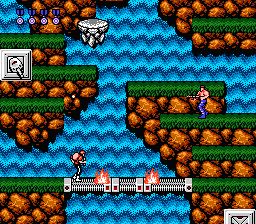




























































































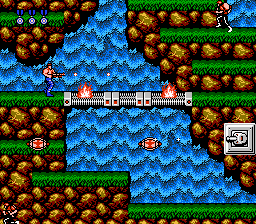
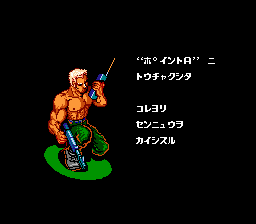

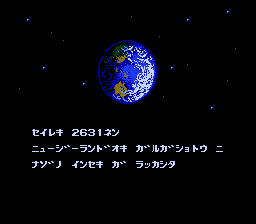
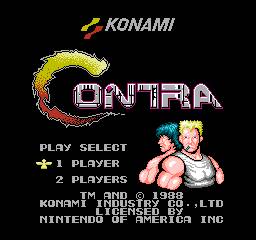
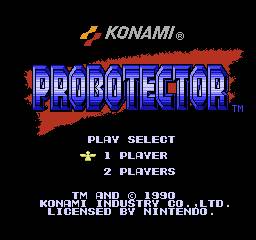
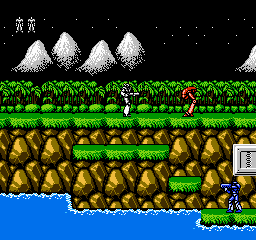



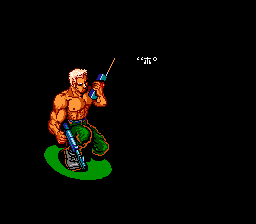
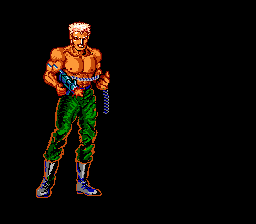



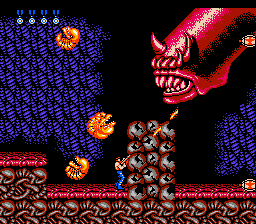
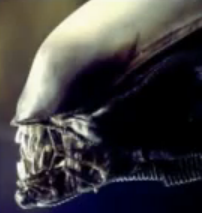









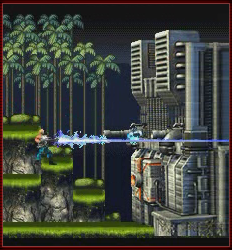
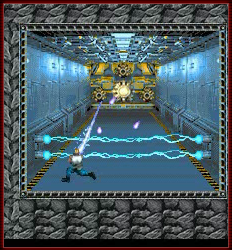


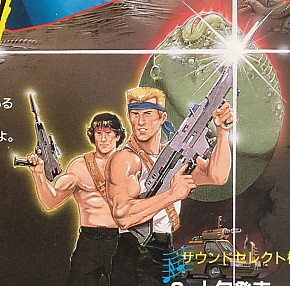
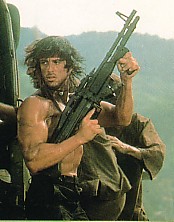


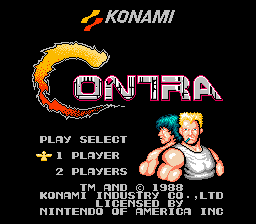
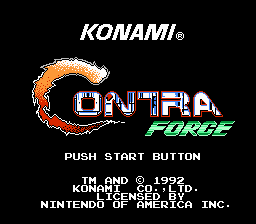

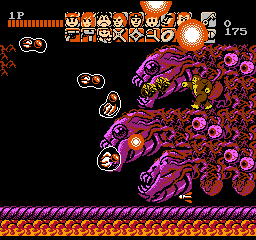
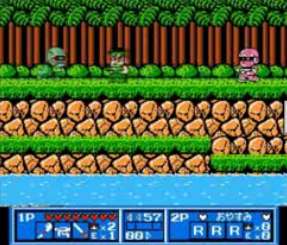

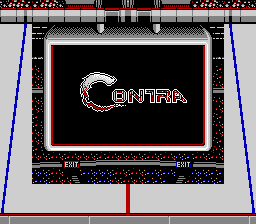






































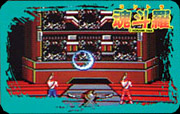



September 9, 2023 at 7:18 pm
That poster is fan-made
https://www.pixiv.net/en/artworks/23386156
September 16, 2023 at 12:04 am
Thanks for the heads-up. Will remove it.